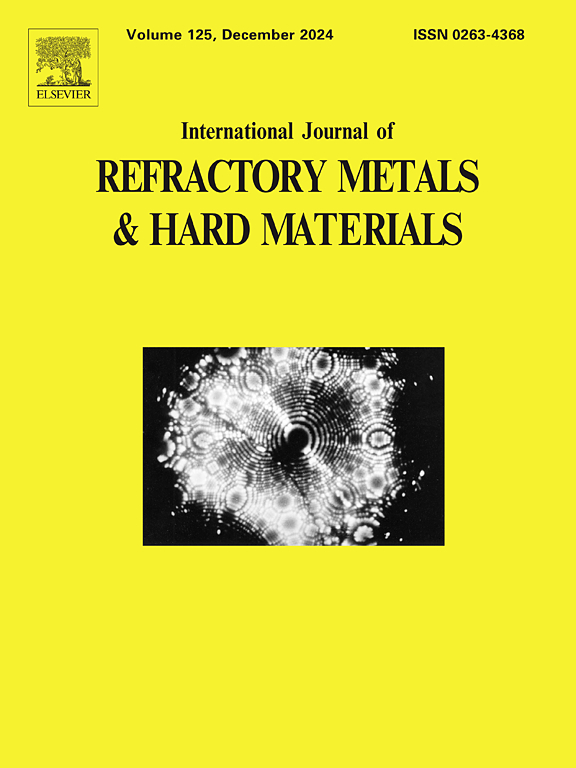WC-Co硬质合金的损伤容限和残余疲劳强度/寿命
IF 4.2
2区 材料科学
Q2 MATERIALS SCIENCE, MULTIDISCIPLINARY
International Journal of Refractory Metals & Hard Materials
Pub Date : 2025-02-25
DOI:10.1016/j.ijrmhm.2025.107117
引用次数: 0
摘要
评估WC-Co硬质合金(也称为硬质合金)在循环载荷下的损伤容限,不仅需要引入可控损伤,而且需要针对损伤样品制定合适的测试方案,旨在分离微观结构对疲劳敏感性和损伤严重程度的影响。为了解决这一挑战,本文将锥形压痕与弯曲测试以及详细的光学和电子显微镜检查相结合,以评估不同粘结剂含量的三种细粒度WC-Co硬质合金牌号的疲劳行为。实验结果表明,微观结构对残余疲劳强度/寿命的影响趋势相反,这取决于在预先存在的损伤场景中是否存在压痕诱发的裂纹特征。因此,随着粘结剂含量的增加,在循环载荷下,“仅压痕无裂纹”诱发硬质合金强度降低的敏感性上升,而通过锥形压痕引入“压痕加裂纹”则降低。考虑到裂纹的亚临界扩展控制着硬质合金的疲劳寿命,这种差异是合理的;因此,取决于它们的裂纹扩展规律的折衷效应-对自然缺陷和人工缺陷都是一样的-以及初始和最终尺寸-分别间接和直接依赖于断裂韧性。因此,这一内在力学性能成为确定这些材料有效损伤容限的关键参数,因为它既决定了疲劳敏感性,也决定了压痕引起的人工缺陷的初始尺寸。这种说法得到了对所研究的最硬硬质合金(而不是其他两种更脆的等级)的疲劳强度/寿命数据重叠的观察的支持,并且在所有测试样品的归一化应用应力-循环次数到失效曲线中有类似的斜率,与所考虑的损伤情况无关。这表明钴含量较高的硬质合金是对机械可靠性要求较高的材料选择,特别是当后者在类似服务条件下涉及过早开裂时。本文章由计算机程序翻译,如有差异,请以英文原文为准。
Damage tolerance and residual fatigue strength/life of WC-Co cemented carbides
Assessment of damage tolerance of WC-Co cemented carbides, also referred to as hardmetals, under cyclic loading requires not only the introduction of controlled damage, but also appropriated testing protocols on the damaged samples aiming to separate the influence of microstructure on both fatigue sensitivity and damage severity. Attempting to address such a challenge, conical indentation is here combined with flexural testing as well as detailed optical and electron microscopy inspection to evaluate the fatigue behavior of three fine-grained WC-Co cemented carbide grades with varying binder content. Experimental findings show opposite microstructural influence trends on the residual fatigue strength/life, depending on the absence or evidence of indentation-induced cracking features in the pre-existing damage scenario. Hence, as the binder content increases, susceptibility of hardmetals to strength lessening under cyclic loads rises when “just imprints without cracks” are induced, but diminishes when “imprints plus cracks” are introduced by means of conical indentation. Such differences are rationalized by considering that fatigue life of hardmetals is controlled by the subcritical propagation of flaws; and thus, depends upon the compromising effect of their crack growth law – same for both natural and artificial defects –, as well as the initial and final sizes – dependent indirectly and directly on fracture toughness, respectively. As a consequence, this intrinsic mechanical property emerges as the key parameter for tailoring effective damage tolerance in these materials because it defines both fatigue sensitivity as well as the initial size of the indentation-induced artificial flaws. Such statement is sustained by the observation for the toughest cemented carbide studied (and not for the other two more brittle grades) of fatigue strength/life data overlapping and a similar slope in the normalized applied stress – number of cycles to failure curves for all the specimens tested, independent of the damage scenario under consideration. This points out hardmetals with higher cobalt contents as preferable material choices for applications requiring mechanical reliability in terms of damage tolerance, particularly if the latter involves premature cracking when subjected to service-like conditions.
求助全文
通过发布文献求助,成功后即可免费获取论文全文。
去求助
来源期刊
CiteScore
7.00
自引率
13.90%
发文量
236
审稿时长
35 days
期刊介绍:
The International Journal of Refractory Metals and Hard Materials (IJRMHM) publishes original research articles concerned with all aspects of refractory metals and hard materials. Refractory metals are defined as metals with melting points higher than 1800 °C. These are tungsten, molybdenum, chromium, tantalum, niobium, hafnium, and rhenium, as well as many compounds and alloys based thereupon. Hard materials that are included in the scope of this journal are defined as materials with hardness values higher than 1000 kg/mm2, primarily intended for applications as manufacturing tools or wear resistant components in mechanical systems. Thus they encompass carbides, nitrides and borides of metals, and related compounds. A special focus of this journal is put on the family of hardmetals, which is also known as cemented tungsten carbide, and cermets which are based on titanium carbide and carbonitrides with or without a metal binder. Ceramics and superhard materials including diamond and cubic boron nitride may also be accepted provided the subject material is presented as hard materials as defined above.

 求助内容:
求助内容: 应助结果提醒方式:
应助结果提醒方式:


